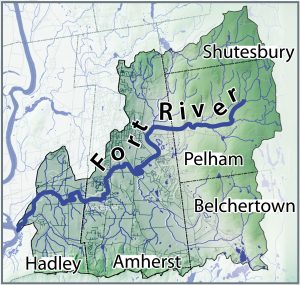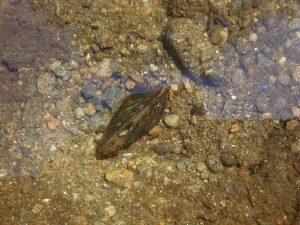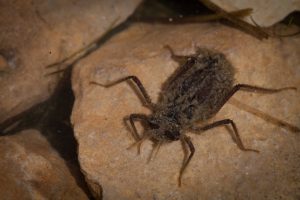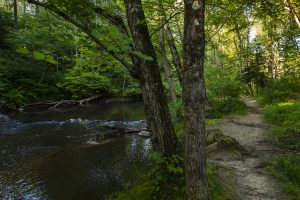What’s so special about the Fort River watershed? We’ll tell you!
The Fort River watershed refers to all of the land from which water drains into the Fort River.
Watersheds are like sinks – all the water that goes into your bathroom or kitchen sink will ultimately make its way to the drain at the bottom. Similarly, all the water that falls on a watershed area will ultimately make its way to a river or ocean.
In our case, all the water that falls on the Fort River watershed drains into the Fort River, after flowing over our yards and streets, schools and playgrounds, roofs and buildings, fields, farms and forests.
 The Fort River is a 13-mile-long tributary in western Massachusetts that flows from east to west into the Connecticut River.
The Fort River is a 13-mile-long tributary in western Massachusetts that flows from east to west into the Connecticut River.
What’s so special about the Fort River?
- FREE FLOWING – The Fort River is the longest tributary of the Connecticut River with no dams – this offers free passage for fish and other species.
- WELL-WATERED COMMUNITIES – The Fort River supplies drinking water for the residents of Amherst. The river and its watershed (the land that drains in to it) spans across parts of Amherst, Belchertown, Hadley, Pelham, and Shutesbury.
- WILDLIFE – The Fort River is home to several species of freshwater mussel, including one species federally listed as endangered – the dwarf wedgemussel. Mussels are extremely sensitive to pollution and degraded water quality. Several species of migratory fish also call the Fort River home for part of their life.
What’s living in the Fort River?
FISH
There are 25 known fish species residing in the Fort River. Sixteen of these are native, 9 are non-native (introduced by people at some point in history).
While most of the fish species in the Fort River are full-time river residents, there are 2 species that are migratory: they live in the fresh water of the Fort River for part of their life cycle, and in the salty ocean water for another part of their life cycle. The link between the Fort River and the Atlantic Ocean is the Connecticut River, the highway for many migratory fish.
The scientific term for fish that move between fresh and salty water is diadromous.
There are two kinds of diadromous fish: Fish that migrate from fresh to salt water to have their babies are called catadromous, while fish that migrate from salt to fresh water to have their babies are called anadromous. In the Fort River, we are lucky to have both! We have a catadromous fish, the American eel, AND an anadromous fish, the sea lamprey.
 In addition to all of the fish, resident and migratory, the Fort River is home to a federally endangered freshwater mussel – the dwarf wedgemussel. These animals filter water and keep our local rivers clean and clear. They are particularly sensitive to contaminated waterways – we can help keep them here and keep them healthy by keeping the Fort River clean.
In addition to all of the fish, resident and migratory, the Fort River is home to a federally endangered freshwater mussel – the dwarf wedgemussel. These animals filter water and keep our local rivers clean and clear. They are particularly sensitive to contaminated waterways – we can help keep them here and keep them healthy by keeping the Fort River clean.
BUGS
Bugs that live in the river are also called aquatic invertebrates. Translated, this term identifies living things with no bony spine that live in fresh water. Pretty neat!
 From spring to fall in the Fort River, these bugs, or, aquatic invertebrates, drift downstream towards the place where the Fort River meets the mighty Connecticut River. During this same time, migratory fish are swimming upstream –the opposite direction!
From spring to fall in the Fort River, these bugs, or, aquatic invertebrates, drift downstream towards the place where the Fort River meets the mighty Connecticut River. During this same time, migratory fish are swimming upstream –the opposite direction!
These river bugs are at the bottom of the Fort River food chain, providing food to many of the fish in the river. They can be found foraging for their own food in the plants and woody debris along and throughout the river.
TEMPERATURE ZONES
Three of the major tributaries that feed the Fort River have headwaters that are very cold. This cold water comes from underground springs in the local mountains.
The Hadley reach of the Fort River is much warmer than these cold headwaters. This creates what’s called a temperature zonation, or, different zones within the same ecosystem that have different characteristics, like temperature. Different zones have their own sets of conditions that determine the critters that live there—different zones create different conditions for different critters. In the Fort River, we find that the shady cooler waters in the upper reaches attract fish dependent on cooler waters, like native brook trout and slimy sculpin, called stenothermal species. Those fish will not be found in the warmer waters of the main stem, where the sun shines on the water and where you will find species like black bass and catfish.
RIVER BED ZONES
We also find a zonation of habitat along the bottom of the Fort River. Abundant rocks in the upper half of the main stem, and soft sandy clay in the lower half of the main stem, create changes in the habitat available for wildlife and plants. The changes in fish species that we observe in the Fort River throughout the year are especially noticeable around spawning time, or, when fish are making more fish babies. Some fish will migrate to the rocky reaches of the river to build nests among the rocks, like Sea lamprey and Fallfish. Other species like to burrow into the soft sandy river bottom in the lower reaches to feed and hide from predators.
TREES & THE RIVER SHORELINE
 There are a lot of trees along the shores of the Fort River, what we would call a “mixed” forest – containing both evergreen and deciduous trees.
There are a lot of trees along the shores of the Fort River, what we would call a “mixed” forest – containing both evergreen and deciduous trees.
Evergreen trees are trees that always have leaves or needles on them like pines or hemlocks
Deciduous trees are trees that lose their leaves in the fall and sprout new leaves in the spring like oaks and maples
The abundance of trees that cast shady shadows on the river can keep the water cool during the warmest parts of the summer.
The trees along the shoreline provide more complete shade in the narrow reaches of the headwaters than along the wider main stem of the Fort River where the forest is not as dense. Abundant vegetation and woody debris in the river provide abundant food and hiding places for the many aquatic insects, and the fish that feed on them are usually not far behind!
EVER-CHANGING ECOSYSTEM
 The Fort River has what’s called a dynamic stream ecology – meaning that the characteristics of the river that influence the critters that live in the river change over time. In the case of the Fort River, the stream ecology (or, characteristics impacting living things) changes primarily due to two factors: 1) trees along the shoreline of the river (also called the riparian zone), and 2) water flow.
The Fort River has what’s called a dynamic stream ecology – meaning that the characteristics of the river that influence the critters that live in the river change over time. In the case of the Fort River, the stream ecology (or, characteristics impacting living things) changes primarily due to two factors: 1) trees along the shoreline of the river (also called the riparian zone), and 2) water flow.
A tree falling into the river can dramatically change the ecology of the area it falls into in a matter of a couple of days by altering the way the water moves around the fallen tree. This can quickly turn a reach of river flowing freely at a medium pace into a fast-moving run and a deep, slow pool.
Water flow in the Fort River is also very dynamic, quickly changing ecological conditions after a major rainfall event. Typically, the Fort River rises quickly after major rainfall events and during snowmelt. More water in the river changes the water flow, often increasing speed at which the water moves and sometimes causing areas to be flooded that are usually not under water.
As the climate continues to change, an increase in major rainfall events and the frequency of flooding are two ways in which the Fort River and the community around it will continue to be impacted.
Source: Boyd Kynard, Ph.D., BK-Riverfish, LLC & Environmental Conservation Department, UMass, Amherst
Photo credit: Ben Barnhart
